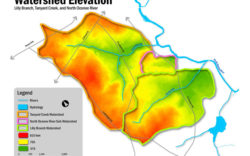You’re not alone if you think your Georgia Power bill is confusing and its calculation seems as mysterious as the posi-trac rear end on a Plymouth. Part of my job for seven years was de-mystifying bills for business owners around the state, because I believe that the more you understand about how you buy energy, the more you’ll think about how to use less of it. This article is geared more for residential customers, whose bills are a bit simpler.
The quantity of electricity we buy every month is measured in kilowatt-hours (kWh). Watts and kilowatts (1,000 watts) are units of power. Energy is equal to power multiplied by time, so the kilowatt-hour is literally kilowatts times hours. If you think of the electricity you buy in terms of water filling up a tank, kilowatts (power) is how fast the water is flowing at any given moment, and kilowatt-hours (energy) is how much water is in the tank at the end of the month.
In the old days, your meter had a wheel that spun faster with more power and would tick the kWh counter as it went around, and a meter reader would walk up and read that counter each month. Now, it’s all digital, and the information is sent to headquarters by radio, but there’s still a nostalgic LCD representation of the spinning wheel on today’s smart meters.
Pull out your last bill, or if you’ve gone paperless, log in and open the PDF. Do you usually look for the due date and the dollar amount at the top and then ignore the rest? Do you ever look at the bar graph near the bottom that shows the last 13 months of usage? Did you even know there’s a whole second page of fascinating information?
On the second page, you can get a glimpse of how the bill is calculated. At the top is the name of the rate plan you’re on; for most readers, it will be “residential.” Then you have the beginning and end dates of the billing period, the meter number (just for fun, go out and make sure it matches your meter) and the actual meter readings used to determine this month’s kWh usage.
Below that is the itemized list of fees that make up the total bill. Of these, “current service” is probably the most cryptic, but the Public Service Commission has an online calculator to help explain it. What isn’t shown on your bill but is included in this line item is a $10 monthly base charge, plus the cost for kWh usage that is calculated with tiered rates like your water bill. It also includes the Fuel Cost Rider, which is a variable add-on that depends on the cost of coal and gas, and the Demand Side Management Rider, a small fee to help pay for energy efficiency rebates. The tiered energy rates increase between June and September, which is why even if your usage is constant, you may see your cost go up in the summer.
Environmental Compliance Cost is the next item, which right now is calculated as 11 percent of the sum of the base charge and kWh charge, and is used to pay for emissions controls and other regulated environmental measures. Nuclear Construction Cost Recovery is a similar 9 percent add-on that is paying for the construction of two new nuclear units at Plant Vogtle. The Municipal Franchise fee is used to pay for power-line easements. The more you use, the more you pay into these fees.
The basic residential rate is relatively simple. You pay for the total quantity you use in a month, and while rates vary seasonally, you pay the same rate regardless of the time of day or week you use it. However, it is more expensive (and more polluting) to generate electricity during peak demand periods than not, so the residential rate tends to average that out. Next time I will write about how you can save money while you reduce pollution and stress on the grid by switching to a different rate plan.
Got a question for the Greensplainer? Email [email protected]
Like what you just read? Support Flagpole by making a donation today. Every dollar you give helps fund our ongoing mission to provide Athens with quality, independent journalism.









